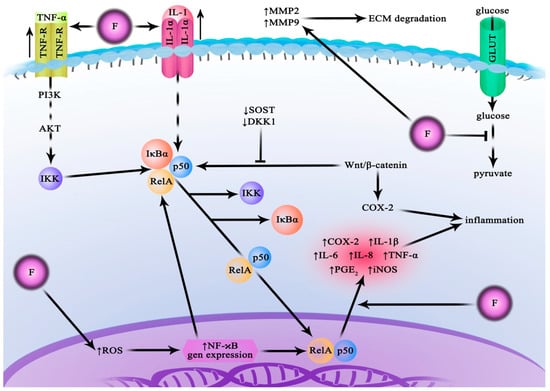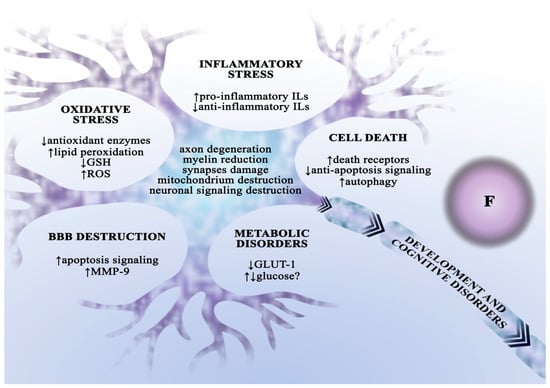You're using an outdated browser. Please upgrade to a modern browser for the best experience.
Please note this is a comparison between Version 1 by Agnieszka Maruszewska and Version 2 by Sirius Huang.
Fluorine in its elemental form is practically not found on Earth, but it is present in the ecosphere in the form of fluorine compounds. A growing body of literature suggests that labelling fluorides as an environmental toxin appears to be correct.
- fluoride
- environmental pollution
- neurotoxicity
1. Fluoride as an Environmental Toxin
Fluoride is regarded as an environmental pollutant associated with serious effects on the functioning of organisms and ecosystems [1][32]. Fluorine in its elemental form is practically not found on Earth, but it is present in the ecosphere in the form of fluorine compounds. They occur naturally in a wide variety of minerals in the Earth’s crust, from where fluorides are released into the soil and water through the Earth’s volcanic activity and rock erosion [2][3][33,34]. Fluoride may pose a threat to human health, which has been specifically documented for populations inhabiting industrialised areas. In these areas, soil and water fluoride levels are elevated due to release from anthropogenic sources. These include fertilizers, pesticides, and deposits of industrial air pollution. Sources of industrial fluoride emissions include combustion of fluoride-rich coal, petroleum refining, production of steel, clay, glass, enamels, bricks and ceramics, manufacture of chemicals, and nuclear fuels [1][2][32,33].
The fluorides distributed in soil, air, and water are accumulated by plants and animals [4][35]. Consequently, drinking water, which may also be artificially fluoridated as a public health measure, and food are major sources of fluoride uptake in humans. The degree of fluoride exposure is affected by the quality of food and water, the amount consumed, as well as individual variability [5][6][7][8][36,37,38,39].
The harmfulness of fluoride has been the topic of intense debate in the last twenty years. There are different opinions as to the role of fluorine as an essential element and the magnitude of its toxic effects on humans (especially through water fluoridation) [9][40], but a growing body of literature suggests that labelling fluorides as an environmental toxin appears to be correct.
The effects of fluoride on the human body can be considered in two ways. Low supply of fluoride interferes with dental enamel formation and promotes growth of cariogenic oral bacteria, leading to dental caries. Fluoride deficiency also causes bone demineralization [1][3][10][32,34,41]. On the other hand, through complex molecular mechanisms of fluoride action on the cellular level, acute and chronic exposure to elevated doses may trigger a broad spectrum of disorders, both physiological and developmental.
Fluoride has been shown to inhibit or activate numerous enzymes crucial for cell metabolism and signalling (Figure 1). It suppresses the activity of Mg-dependent enzymes, including those that catalyse glycolytic reactions. It has also been shown to inhibit pyrophosphatases, ATPases, acetylcholinesterase, and cytochrome c oxidase. On the other hand, stimulatory effects of fluoride have been observed in, for example, glycogen phosphorylase, aspartate transaminase, and tyrosine kinase [9][40]. Furthermore, fluoride influences intracellular signal transduction pathways by affecting signalling cascades involving, e.g., G proteins, adenylate cyclase, Hedgehog proteins, and transcription factors such as NF-κB and Nrf2 [11][12][42,43]. It has also been demonstrated to induce abnormal methylation in some regions of the genome [13][44]. Consequently, with increased exposure, fluorine compounds can exert toxic effects, including organelle damage, oxidative stress on the cellular level, cell cycle disruption, inflammatory cytokine secretion, induction of apoptosis, and disruption of synaptic neurotransmission [9][14][15][40,45,46]. Fluoride is also regarded as a potential endocrine disruptor leading to the development of thyroid dysfunction [16][47].

Figure 1. Fluoride action in normal cells. Fluoride affects normal cells in a pro-inflammatory manner, which is associated with the activation of the NF-kB pathway. As an inhibitor of glycolysis enzymes, it leads to disturbances in energy metabolism. AKT—protein kinase B; COX-2—cyclooxygenase-2; DKK1—Dickkopf-related protein 1; GLUT—glucose transporter; IKK—IκB kinase; Il—interleukin; iNOS—inducible nitric oxide synthases; IκBα—nuclear factor of kappa light polypeptide gene enhancer in B-cells inhibitor alpha; MMP—matrix metalloproteinase; NaF—sodium fluoride; NF-κB—nuclear factor kappa-light-chain-enhancer of activated B cells; p50—NF-kappa-B p105 subunit; PGE2—prostaglandin E2; PI3K—phosphoinositide 3-kinase; RelA—NF-kappa-B p65 subunit; ROS—reactive oxygen species; SOST—clerostin protein; TNF—tumour necrosis factor; TNFR—tumour necrosis factor receptor; Wnt/β-catenin—Wnt signalling pathway.
2. Fluoride Neurotoxicity
One of the better-known toxic effects of chronic fluoride exposure is dental and bone fluorosis, manifested by structural abnormalities in dental enamel as well as bones, ligaments, and tendons [3][34]. Besides teeth and bones, fluoride accumulates in soft tissues, hence chronic exposure can cause damage to the liver, kidneys, cardiovascular system, and reproductive system [17][18][19][20][21][22][23][48,49,50,51,52,53,54]. Still, perhaps the most concerning data point to the significant role of fluoride as a neurotoxin, fluoride penetrates the BBB and alters the structure and function of nervous tissue [24][25][26][27][24,55,56,57]. Furthermore, in a study with a rat model, chronic fluoride exposure was shown to increase the levels of metalloproteinase 9 (MMP-9) and p53 protein, leading to cell apoptosis and damage of the blood–spinal cord barrier [28][58]. The neurodegenerative effects of fluoride are particularly critical in the early stages of biological development, which many authors attribute to its ability to cross the blood–placenta barrier [29][59]. Fluoride causes degenerative changes in all parts of the brain and in the spinal cord, including axon deterioration, myelin sheath degeneration, mitochondrial damage, and alterations in synaptic ultrastructure [26][30][56,60]. It also affects neurotransmitter metabolism and causes changes in the expression of neurotransmitter receptors [31][32][33][61,62,63]. Fluorine compounds impair energy metabolism of the brain, dependent primarily on the burning of glucose. Fluoride exposure may be associated with changes in the profile of proteins involved in energy metabolism [34][64], and researchers have suggested that impaired glucose metabolism in neurons is correlated with decreased expression of the GLUT-1 transporter [35][65]. On the other hand, increased glucose transport into brain cells has also been documented, although without changes in transporter expression, suggesting a compensatory mechanism in response to damage [36][66]. Chronic fluoride exposure also affects amino acid and lipid metabolism [31][37][61,67]. Neuronal damage as a result of exposure to high doses of fluoride is associated with the induction of cellular oxidative stress and inflammation. In vitro and in vivo studies have shown that fluoride increases ROS levels through lipid peroxidation, decreasing GSH levels, and suppressing antioxidant enzyme activity [38][39][40][68,69,70]. Fluoride exposure results in increased secretion of pro-inflammatory interleukins and decreased production of anti-inflammatory interleukins [11][38][41][42,68,71]. Fluoride-induced neuronal degeneration is associated with the activation of apoptotic signalling cascades [42][72], increased expression or higher levels of death receptors [43][73] and pro-apoptotic proteins [28][41][44][58,71,74], as well as caspase activation [38][43][68,73] and downregulation of anti-apoptotic protein expression [41][71]. Neuronal degeneration can also occur via autophagy (Figure 2) [45][75].

Figure 2. The neurodegenerative effect of fluoride. The toxic effect of fluoride on the central nervous system is multidimensional—it results from disturbances in metabolism regulation, synaptic functioning, the blood–brain barrier integrity, as well as oxidative stress and inflammation induction in neurons and microglia cells. These multidimensional interactions are believed to cause developmental and cognitive impairments in the body. ADHD—attention deficit hyperactivity disorder; BBB—blood–brain barrier; GLUT—glucose transporter; GSH—reduced glutathione; Ils—interleukins; ROS—reactive oxygen species.
The described molecular-level changes leading to neuronal degeneration manifest themselves in developmental and cognitive disorders that have been observed both in animal models and in population studies. It has been observed that chronic fluoride exposure during the prenatal period and early life may manifest as deficits in learning and memory, reduced non-verbal intelligence (PIQ), and lower intelligence quotient (IQ) [24][46][47][48][49][24,76,77,78,79]. Some authors have also suggested that elevated fluoride levels are correlated with the risk of dementia [50][80] and ADHD prevalence [51][81]. It should be noted that many authors disagree with these conclusions, arguing that population-based studies are incomplete. They also note that many of the behavioural studies were conducted in animal models utilizing acute doses [52][53][54][55][21,82,83,84]. Nevertheless, as Till and Green [56][85] point out, the evidence is relatively new and should rather be regarded as a potential early warning.
